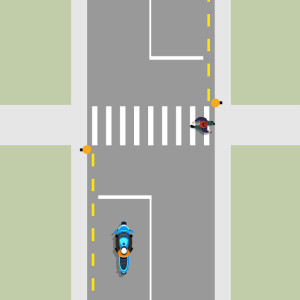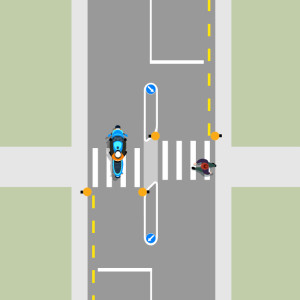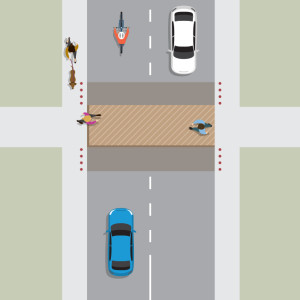On average, 36 pedestrians are killed and 1000 pedestrians are injured on New Zealand roads every year.
Many of these deaths and injuries could be prevented if drivers took more care when using our roads. Please look out for pedestrians whenever you’re riding your motorcycle.
A pedestrian crossing is an area of road that has white stripes marked across it. It’s used by pedestrians and people using mobility devices, such as motorised wheelchairs, as well as skateboards and foot-propelled scooters.
Some crossings have raised islands in the middle where pedestrians can stop. These help pedestrians crossing wide, 2-way roads or multi-laned roads.
As you ride towards a pedestrian crossing, you’ll see pedestrian crossing signs before the crossing and black and white poles at the crossing. The poles have fluorescent orange disks, or round yellow lights that flash at night.
White diamonds are generally painted on the road before the crossing and a white limit line shows you where to stop.
When coming up to pedestrian crossings:

Pedestrian crossing

Pedestrian crossing with a raised island
If you’re in a queue of traffic near a pedestrian crossing, don’t move onto the crossing if there isn’t enough room for your vehicle on the other side of the crossing.
If there’s a raised traffic island in the middle of the crossing, stop and give way to pedestrians on your half of the road.
ImportantNever overtake a vehicle that’s slowing down for a pedestrian crossing or has stopped to let someone cross. |
Courtesy crossings are usually made of bricks or paving and are often raised above the level of the road.
Although not official pedestrian crossings, they provide a safe place for pedestrians to cross. You should be courteous to people using a courtesy crossing.

Courtesy pedestrian crossing
This is a road that’s been designed to slow traffic and give priority to pedestrians. Drivers and riders give way to pedestrians who, in turn, should not hold up traffic.
School crossings, also known as kea crossings, provide a safe place for children to cross the road. They generally only operate before and after school.
When school crossings are operating, a fluorescent orange Children sign will be displayed, along with a school patrol stop sign, which swings out into the road.
When the school patrol stop sign is out, vehicles coming from both directions must stop until all signs have been pulled in.

School patrol stop sign
Keep a lookout for children at all times. Take special care when riding during 8–9am and 3–4pm, when children are travelling to and from school.
People who are blind or vision-impaired often use aids such as a white cane or a guide dog. When you see people with these aids trying to cross the road, you should take extra care and let them cross in their own time.
When you’re entering or leaving a driveway that crosses a footpath, you must give way to people using the footpath.
When leaving a driveway, you must give way to vehicles using the road.